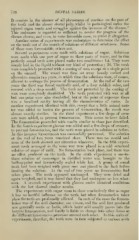Page 738 - My FlipBook
P. 738
748 DENTAL CARIES.
It consists iu the absence of all phenomena of reaction on the part of
the tooth and the absent dental pulp, whilst in pathological caries the
injured organ reacts and struggles against the invasion of the disease."
This resistance is regarded as sufficient to render the progress of the
disease slower, and even, in some favorable cases, to arrest it altogether.
Another series of experiments was undertaken to determine the effect
on the teeth out of the mouth of solutions of different substances. Some
of these were fermentable, others not.
Several experiments were made with solutions of sugar. Solutions
were made with one part of sugar to three parts of water, and in this
perfectly sound teeth were placed under two conditions : 1st. They Mere
simply laid in the liquid without any kind of protection ; 2d. The teeth
were completely protected with a coating of wax except at a single point
on the enamel. The vessel was then set away loosely corked and
allowed to remain two years, in which time the solutions were, of course,
allowed to undergo the process of fermentation. At the end of the two
years the fluid was found markedly acid, of a deep reddish color, and
covered with a deep mould. The teeth not protected by the coating of
wax were completely decalcified. The teeth protected with wax at all
but one point were also decalcified, but at the point of exposure there
was a localized cavity having all the characteristics of caries. In
another experiment identical with this, except that a little animal mat-
ter was added to hasten the process of fermentation, the result was
almost exactly similar. In the third experiment a few drops of crea-
sote were added, to prevent fermentation. This seems to have failed.
The fermentation proceeded with results similar to those just described.
In the fourth experiment glucose was added and a few drops of creasote,
to prevent fei»mentation, and the teeth were placed in solution as before.
In this instance fermentation was successfully prevented. The solution
at the end of tM'o years remained clear. There was no mould and
none of the teeth showed any alteration whatever. In the fifth experi-
ment teeth arranged in the same way were placed in a cold saturated
solution of sugar of milk. No fermentation took place, and there w^as
no effect produced on the teeth. In the sixth experiment a one-to-
three solution of cane-sugar in distilled water was brought to the
boiling-point and hermetically sealed while hot. A group of sound
teeth had been weighed with great care and placed in the flask before
heating the solution. At the end of two years no fermentation had
taken place. The teeth appeared unchanged. They were dried and
again weighed, and it was found that they had undergone no loss what-
ever. A seventh experiment with glucose under identical conditions
with tlie last showed similar results.
The experiments with sugar seem to show conclusively that as sugar
it has no hurtful influence on the teeth, but when fermentation takes
place the teeth are profoundly affected. In each of the cases the fermen-
tation was of the acid character, not vinous, and the acid first produced
was generally acetic or lactic, which latter acid usually passes into the
butvric fermentation, and finally is liable to change into other forms as
the different fermentative processes succeed each other. In this series of
experiments, therefore, the teeth were in turn subjected to various acids


